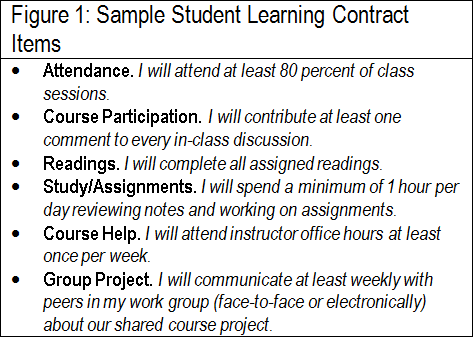A new, streamlined version of Intervention Central is coming in December 2023. The new site will eliminate user login accounts. If you have a login account, be sure to download and save any documents of importance from that account, as they will be erased when the website is revised.
Main menu
How to: Increase Motivation: Learning Contracts
![]()
![]() Description. A learning contract is a voluntary, student-completed document that outlines actions the learner promises to take in a course to achieve academic success. This contract is signed by the student, the instructor, and (optionally) the parent. Benefits of all such contracts, however, are that they provide academic structure and support, motivate struggling learners by having them pledge publicly to engage in specific, positive study and learning behaviors, and serve as a vehicle to bring teachers and students to agreement on what course goals are important and how to achieve them (Frank & Scharff, 2013). (View an example of a completed learning contract )
Description. A learning contract is a voluntary, student-completed document that outlines actions the learner promises to take in a course to achieve academic success. This contract is signed by the student, the instructor, and (optionally) the parent. Benefits of all such contracts, however, are that they provide academic structure and support, motivate struggling learners by having them pledge publicly to engage in specific, positive study and learning behaviors, and serve as a vehicle to bring teachers and students to agreement on what course goals are important and how to achieve them (Frank & Scharff, 2013). (View an example of a completed learning contract )
Procedure. The learning contract is typically completed in a meeting between the student and instructor. (In middle and high schools, the parent may also be a participant.) While there are many possible variations on the learning contract, they often contain these components (Frank & Scharff, 2013; Greenwood & McCabe, 2008):
- Statement of Purpose. The contract opens with a statement presenting a rationale for why the contract is being implemented. A sample statement might be: I am taking part in this learning contract because I want to improve my grades and pass this course.
 Student Actions. The contract lists any actions that the student is pledging to complete to ensure success in the course. Suitable targets for learning contract items might include attendance, class participation, completion of classwork or homework, seeking of instructor help, etc. See Figure 1 for a listing of sample actions that might be written into a learning contract.
Student Actions. The contract lists any actions that the student is pledging to complete to ensure success in the course. Suitable targets for learning contract items might include attendance, class participation, completion of classwork or homework, seeking of instructor help, etc. See Figure 1 for a listing of sample actions that might be written into a learning contract.
- Teacher Actions. The learning contract can be strengthened by adding a section detailing those actions that the instructor agrees to undertake to support the student. For example, the contract might state that the instructor will respond within 24 hours to course questions emailed by the student or will check weekly and alert the student to any missing course work. Listing teacher responsibilities on the contract emphasizes that success in the course is a shared endeavor and can prod the student to take advantage of instructor supports that might otherwise be overlooked.
- Sign-Off. Both student and teacher sign the learning contract. If the parent is participating in the development of the contract, he or she also signs the contract. Because this document is a kind of 'promissory contract' (Rousseau & Parks, 1993), the student signature in particular indicates a voluntary acceptance of the learning contract and a public pledge to follow through on its terms.
Tips for Use. Here are additional ideas for using learning contracts:
- Contracts and Whole-Group Instruction. If a number of students in a class would benefit from learning contracts as a motivational tool, teachers can incorporate them into whole-group instruction. For example, an instructor may write a series of learning-contract goals on the board (similar to the list appearing in Figure 1) and direct each student to select 3 or 4 to include in his or her own contract. The teacher would collect copies of all learning contracts and hold every student accountable for their use.
- Contracts & Enrichment. Learning contracts can also be a convenient way to document individualized plans for enriched instructional activities. Advanced students can fill out contracts detailing their ambitious, self-directed learning goals; these contracts can also describe extra credit or other forms of recognition that students will earn for these enrichment activities.
Attachments
References
- Frank, T., & Scharff, L. F. V. (2013). Learning contracts in undergraduate courses: Impacts on student behaviors and academic performance. Journal of the Scholarship of Teaching and Learning, 13(4), 36-53.
- Greenwood, S. C., & McCabe, P. P. (2008). How learning contracts motivate students. Middle School Journal, 39(5), 13-22.
- Rousseau, D. M., & Parks, J. M. (1993). The contracts of individuals and organizations. Research in Organizational Behavior, 15, 1-43.
